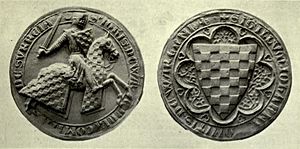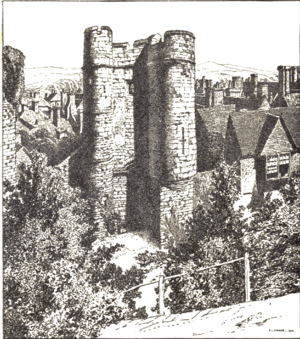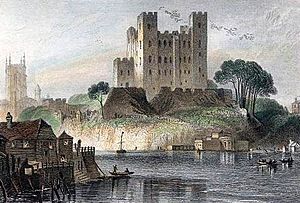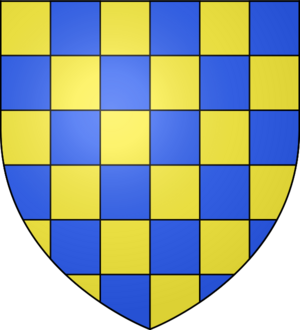John de Warenne, 6th Earl of Surrey facts for kids
Quick facts for kids
John de Warenne
|
|
|---|---|
| Earl of Surrey | |

Warenne's seal from Barons' Letter, 1301
|
|
| Born | 1231 Surrey, England |
| Died | 27 September 1304 (aged around 73) Kennington, Surrey, England |
| Residence | Holt Castle |
| Spouse(s) |
Alice de Lusignan
(m. 1247; |
| Issue | Eleanor de Warenne Isabella de Warenne William de Warenne |
| Father | William de Warenne, 5th Earl of Surrey |
| Mother | Maud Marshal |
John de Warenne, 6th Earl of Surrey (born 1231, died 27 September 1304) was an important English nobleman. He was also a military leader. He lived during the time of King Henry III of England and King Edward I of England.
John de Warenne played a big part in the Second Barons' War. He changed his support between the king and the barons. He ended up supporting the king. He was even there when the king was captured at the Battle of Lewes in 1264. Later, he became a Guardian of Scotland. He was very active in King Edward I's wars against Scotland.
Contents
Early Life and Family

John de Warenne was the son of William de Warenne, 5th Earl of Surrey. His mother was Maud Marshal. Maud was the daughter of a famous knight, William Marshal, 1st Earl of Pembroke. She was also the widow of Hugh Bigod, 3rd Earl of Norfolk. This made Roger Bigod, 4th Earl of Norfolk John's older half-brother.
John was still a boy when his father died. This meant he became a ward of the king. A "royal ward" was someone whose lands were looked after by the king. Peter II of Savoy became the guardian of John's lands. John grew up at the royal court.
In 1247, John married Alice le Brun de Lusignan. She was the half-sister of King Henry III. Many English nobles did not like this marriage. They felt it was wrong for a rich English nobleman to marry a foreigner who had no money.
For several years, John was close to the king's family. In 1254, he traveled with Prince Edward. Prince Edward later became King Edward I. They went to Spain for Edward's marriage to Eleanor of Castile.
The Barons' War

At first, John de Warenne strongly supported King Henry III. But then he switched sides to support Simon de Montfort, 6th Earl of Leicester. Later, he changed back to supporting the king.
In April 1264, John and Roger de Leybourne were trapped inside Rochester Castle. Simon de Montfort's forces surrounded them. In May of that year, John was at the Battle of Lewes. This battle happened near his family home, Lewes Castle.
After the king and Prince Edward were captured, John fled to Europe. He stayed there for about a year. His lands were taken away, but he got them back later. He returned to England to fight in the battles that followed. These included the Battle of Evesham, the Battle of Chesterfield, and the siege of Kenilworth Castle.
Serving King Edward I
John de Warenne fought in King Edward I's campaigns in Wales. These happened in 1277, 1282, and 1283. In 1282, King Edward gave him the Lordship of Bromfield and Yale in Wales. This land was taken from Welsh princes. John also began building Holt Castle there. His son, William, continued the castle's construction.
John spent many years in Scotland. He helped negotiate important agreements. These included the 1289 Treaty of Salisbury and the 1290 Treaty of Birgham. He also joined the king's invasion of Scotland in 1296. He led the main battle that year at the Battle of Dunbar.
Wars in Scotland
On August 22, 1296, King Edward I made John de Warenne the "warden of the kingdom and land of Scotland." But John went back to England a few months later. He said the Scottish weather was bad for his health.
The next spring, William Wallace led a rebellion. The king ordered John to lead his army north. John had refused at first, but he eventually went back to Scotland. He was defeated by Wallace at the Battle of Stirling Bridge. After this loss, he fled to York.
Even so, the king chose John to lead the next campaign against the Scots in early 1298. He helped end the siege of Roxburgh. He also took back the town of Berwick. The king himself joined the fight later that year. John was one of the commanders at the important English victory at the Battle of Falkirk.
In the 1300 campaign, John de Warenne led one of the four cavalry groups in King Edward I's army. On August 8, near the Cree River, Edward ordered his men and John's to charge at a Scottish force. This made the Scots run away.
A Famous Story
In 1278, King Edward I held a meeting in Gloucester. He wanted to find out which lords had taken royal rights, especially the right to make legal decisions. A story says that John de Warenne was asked "by what warrant?" he held his lands.
John supposedly pulled out a rusty sword. He said this was his warrant. He told them, "My ancestors came with William the Conqueror, and they won their lands with the sword. I will defend them with the sword against anyone who tries to take them."
Later Life and Death
John de Warenne died on September 27, 1304. He passed away in Kennington, Surrey. He was buried in Lewes Priory. The Archbishop of Canterbury led his funeral service. His grandson, also named John, became the next Earl of Surrey.
Children
John de Warenne and Alice de Lusignan had three children:
- Eleanor, who married Henry Percy. She was the mother of Henry de Percy, 1st Baron Percy of Alnwick.
- Isabella, who married John Balliol. John Balliol was briefly the King of Scots. Isabella was the mother of Edward Balliol.
- William, who married Joan. Joan was the daughter of Robert de Vere, 5th Earl of Oxford. William died in an accident at a tournament on December 15, 1286. His son, John, became the Earl of Surrey after his grandfather. William's daughter, Alice de Warenne, married Edmund Fitzalan, 9th Earl of Arundel.
Sources
- Ancestral Roots of Certain American Colonists Who Came to America Before 1700 by Frederick Lewis Weis, Lines: 83–28, 153A-20, 153A-29, 161–27.
- Pegge, Samuel (1769). "A succinct and authentic narrative of the Battle of Chesterfield, A.D 1266 in the reign of King Henry III". Archaeologica. XXXVI: 276–285.
| Peerage of England | ||
|---|---|---|
| Preceded by William de Warenne |
Earl of Surrey 1240–1304 |
Succeeded by John de Warenne |


